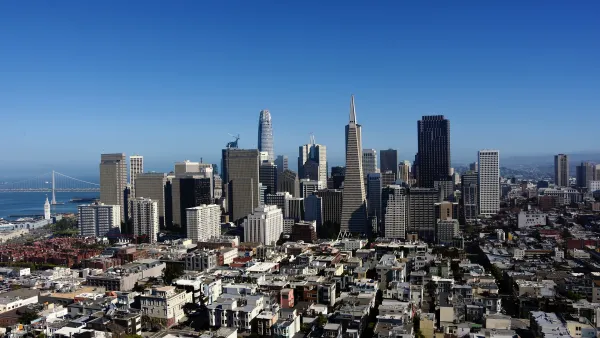I previously lamented the apparent death of industrial use in our cities by the widespread application of terms like “post-industrial” and “rust-belt.” While semantics is an issue, let’s not forget that design matters and, in terms of industrial use, it hasn’t seemed to matter enough in recent years. In times past, industrial use was often a form of pride. Many of the hulking, multi-story industrial buildings in older cities are (still) beautiful additions to our cityscapes. In some cities, those that went vacant have spawned a new form of urban scavenge hunting by those seeking to fuel their appreciation for our industrial past through photography and exploration. Think as well of the WPA posters, many of which used stylized industrial themes to promote our “American” identity.
I previously lamented
the apparent death of industrial use in our cities by the widespread
application of terms like "post-industrial" and "rust-belt." While semantics is an issue, let's not forget
that design matters and, in terms of industrial use, it hasn't seemed to matter enough
in recent years.
In times past,
industrial use was often a form of pride.
Many of the hulking, multi-story industrial buildings in older cities
are (still) beautiful additions to our cityscapes. In some cities, those that went vacant have
spawned a new form of urban scavenge hunting by those seeking to fuel their
appreciation for our industrial past through photography and exploration. Think as well of the WPA posters, many of
which used stylized industrial themes to promote our "American" identity.
But as the urban
industrial sector declined and the suburban distribution and warehousing sector
took off, we lost something in translation.
Urban industrial land often became symbols of contamination and blight
due in part to the often visible vacancy on the fringes of downtowns or along
major rail corridors. At the same time, massive
flat boxes spread across suburban and exurban areas nestled along highways and
often removed from where people live. The
boxes are not so much designed as assembled for just-in-time efficiency.
Rising gas prices
and rising transportation costs among other factors have started to question
whether the big suburban industrial box makes sense. Wouldn't it be cheaper to build facilities
closer to where other processes and consumers are? If that's the case, we need to take another
look at what an urban industrial development might look like.
First off, and it's
easy to say this now in the wake of a national housing crisis, but we need to
re-evaluate our hopes for the future of industrial vacant land. We all know how tempting that large, formerly
industrial site is. While it may be
contaminated, it is also large and under one (maybe a couple) of owners. Its redevelopment could be the catalyst for
new housing and retail. We tell
ourselves, the market has spoken.
Industrial has had its chance and now it's time for something else.
Don't get me wrong, there are certainly times
when formerly industrial land can and should be reclaimed for other uses. But there are also times when industrial sites can be
re-purposed for new industrial uses that fit with the urban context. As with everything, context matters location
matters. Cities have infrastructure and
a diverse workforce that are increasingly recognized as assets to build
on. Let's make the most of them where we
can. Some cities like Chicago, NYC and Portland have gotten out in front of this issue by protecting industrial land from variance requests. These protection areas are hard to policitally come by but a solid public commitment to support continued industrial use.
But the equally
important issue is design. How can we
advocate for new industrial uses when the general perception is that industrial
uses shouldn't be near my house? Infill
Philadelphia, a program of the Community Design Collaborative, organized to "promote workable, innovative design solutions to
revitalizing older, urban neighborhoods," will address this very issue when
they will soon launch a process to explore new design possibilities for urban industrial
uses. The initiative recognizes that we need to re-learn how to build new industries in the city as well as smooth the relationship between existing industrial areas and other uses. As designers and planners, we
can certainly help.
Industrial (urban)
design certainly needs this kind of attention.
Maybe then we'll start to seriously look at the opportunities for new
and existing industrial uses of all stripes.
After all, who wants to plan for where the scrap metal recycling yard
should go .or what it should look like?
It's far more enticing to plan for new urban "fabric," the kind that
creates all those walkable places that got us interested in cities in the first
place. But in an age when jobs and greening
matters, planning for our industrial future should occupy our time and energy
more than it has in the recent past.

National Parks Layoffs Will Cause Communities to Lose Billions
Thousands of essential park workers were laid off this week, just before the busy spring break season.

Retro-silient?: America’s First “Eco-burb,” The Woodlands Turns 50
A master-planned community north of Houston offers lessons on green infrastructure and resilient design, but falls short of its founder’s lofty affordability and walkability goals.

Delivering for America Plan Will Downgrade Mail Service in at Least 49.5 Percent of Zip Codes
Republican and Democrat lawmakers criticize the plan for its disproportionate negative impact on rural communities.

Test News Post 1
This is a summary

Test News Headline 46
Test for the image on the front page.

Balancing Bombs and Butterflies: How the National Guard Protects a Rare Species
The National Guard at Fort Indiantown Gap uses GIS technology and land management strategies to balance military training with conservation efforts, ensuring the survival of the rare eastern regal fritillary butterfly.
Urban Design for Planners 1: Software Tools
This six-course series explores essential urban design concepts using open source software and equips planners with the tools they need to participate fully in the urban design process.
Planning for Universal Design
Learn the tools for implementing Universal Design in planning regulations.
EMC Planning Group, Inc.
Planetizen
Planetizen
Mpact (formerly Rail~Volution)
Great Falls Development Authority, Inc.
HUDs Office of Policy Development and Research
NYU Wagner Graduate School of Public Service





























